Geodynamic, Tectonophysical, and Structural Comparison of the South Caspian and Levant Basins: A Review
Abstract
1. Introduction
2. Materials and Methods
3. Results Obtained
3.1. South Caspian Basin (SCB)
3.2. Iranian Plate
3.3. Levant Basin (LB)
4. Discussion
4.1. Basics for the Multifactorial Comparison
4.2. Short Gravity Field Comparison
4.3. Short Magnetic Field Comparison
4.4. A Very Brief Thermal Field Comparison
4.5. A Very Brief Description of Seismic and Seismotomographic Data
4.6. Sedimentation in the SCB and LB: Short Sketch
4.7. Essential Tectonic-Geodynamic Highlights
4.8. The Directions for Further Research
5. Conclusions
- (1)
- For the first time, a comprehensive multi-component tectonic–geodynamic, sedimentary, and geophysical comparison of the South Caspian Basin and the Levant Basin has been conducted.
- (2)
- The Levant Basin lies above the projected center of a giant, counterclockwise-rotating deep mantle structure and undergoes rotation in the same direction.
- (3)
- The eastern segment of the counterclockwise-rotating deep mantle structure affects the western portion of the Iranian Plate, which has a complex configuration. This interaction drives the Iranian Plate’s movement toward the north and north–northeast, subsequently inducing the clockwise rotation of the South Caspian Basin.
- (4)
- Active geodynamics with the underthrust of the SCB’s thickest terrigenous sedimentary layer under the Absheron ridge, with the simultaneous clockwise rotation, could be one of the reasons for the high intensity of mud volcanism in the basin.
- (5)
- The tectonic–geodynamic analysis indicates that the Earth’s crust under the Levant Basin and South Caspian Basin is mainly allochthonous and autochthonous, respectively.
- (6)
- Low heat-flow values and thick sedimentary layers in both basins provide opportunities to explore commercial hydrocarbon deposits at great depths (8–13 km for the SCB and 7–10 km for the LB).
Author Contributions
Funding
Data Availability Statement
Acknowledgments
Conflicts of Interest
References
- Hall, J.K.; Krasheninnikov, V.A.; Hirsch, F.; Benjamini, C.; Flexer, A. (Eds.) Geological Framework of the Levant. The Levantine Basin and Israel; Historical Productions-Hall: Jerusalem, Israel, 2005; Volume II, 827p. [Google Scholar]
- Ben-Avraham, Z.; Ginzburg, A.; Makris, J.; Eppelbaum, L. Crustal structure of the Levant basin, Eastern Mediterranean. Tectonophysics 2002, 346, 23–43. [Google Scholar] [CrossRef]
- Eppelbaum, L.V.; Katz, Y.I.; Kadirov, F.A. The relationship between the paleobiogeography of the northern and southern sides of the Neotethys and the deep geodynamic processes. ANAS Trans. Earth Sci. 2024, No. 1, 57–76. [Google Scholar] [CrossRef]
- Stampfli, G.M.; Borel, G.D. A plate tectonic model for the Paleozoic and Mesozoic constrained by dynamic plate boundaries and restored synthetic oceanic isochrones. Earth Planet. Sci. Lett. 2002, 196, 17–33. [Google Scholar] [CrossRef]
- Ben-Avraham, Z.; Nur, A.; Jones, D.; Cox, A. Continental accretion and orogeny: From oceanic plateaus to allochthonous terranes. Science 1981, 213, 47–54. [Google Scholar] [CrossRef]
- Motaghi, K.; Tatar, M.; Priestley, K.; Romanelli, F.; Doglioni, C.; Panza, G.F. The deep structure of the Iranian Plateau. Gondwana 2015, 28, 407–418. [Google Scholar] [CrossRef]
- Le Pichon, X.; Şengör, A.M.C.; İmren, C. A new approach to the opening of the eastern Mediterranean Sea and the origin of the Hellenic Subduction Zone. Part 1: The eastern Mediterranean Sea. Can. J. Earth Sci. 2019, 56, 1119–1143. [Google Scholar] [CrossRef]
- Mattei, M.; Visconti, A.L.; Cifelli, F.; Nozaem, R.; Winkler, A.; Sagnotti, L. Clockwise paleomagnetic rotations in northeastern Iran: Major implications on recent geodynamic evolution of outer sectors of the Arabia-Eurasia collision zone. Gondwana Res. 2019, 71, 194–209. [Google Scholar] [CrossRef]
- Eppelbaum, L.V.; Ben-Avraham, Z.; Katz, Y.; Cloetingh, S.; Kaban, M. Giant quasi-ring mantle structure in the African-Arabian junction: Results derived from the geological-geophysical data integration. Geotectonics 2021, 55, 67–93. [Google Scholar] [CrossRef]
- Eppelbaum, L.V.; Katz, Y.I.; Ben-Avraham, Z. A giant quasi-ring mantle structure beneath the Eastern Mediterranean: Interpretation of new magnetic, paleobiogeographic, and seismic tomography data. Geotectonics 2025, 59, 3–31. [Google Scholar] [CrossRef]
- Reilinger, R.E.; McClusky, S.; Vernant, P.; Lawrence, S.; Ergintav, S.; Cakmak, R.; Ozener, H.; Kadirov, F.; Guliyev, I.; Stepanyan, R.; et al. GPS constraints on continental deformation in the Africa-Arabia-Eurasia continental collision zone and implications for the dynamics of plate interactions. J. Geophys. Res. 2006, 111, B05411. [Google Scholar] [CrossRef]
- Kadirov, F.A.; Guliyev, I.S.; Feyzullayev, A.A.; Safarov, P.T.; Mammadov, S.K.; Banayev, G.R.; Rashidov, T.M. Crustal deformations in Azerbaijan according to GPS data and their influence on seismicity and mud volcanism. Phys. Solid Earth 2014, 50, 814–823. [Google Scholar] [CrossRef]
- Kadirov, F.; Yetirmishli, G.; Safarov, R.; Mammadov, S.; Kazimov, I.; Floyd, M.; Reilinger, R.; King, R. Results from 25 years (1998–2022) of crustal deformation monitoring in Azerbaijan and adjacent territory using GPS. ANAS Trans. Earth Sci. 2024, No. 1, 28–43. [Google Scholar] [CrossRef]
- Khorrami, F.; Vernant, P.; Masson, F.; Nilfouroushan, F.; Mousavi, Z.; Nankali, H.; Saadat, S.A.; Walpersdorf, A.; Hosseini, S.; Tavakoli, P.; et al. An up-to-date crustal deformation map of Iran using integrated campaign-mode and permanent GPS velocities. Geophys. J. Int. 2024, 217, 832–843. [Google Scholar] [CrossRef]
- Khain, V.E. Tectonics of Continents and Oceans; Scientific World: Moscow, Russia, 2001; 606p. (In Russian) [Google Scholar]
- Abdullayev, N.R. Analysis of sedimentary thickness, volumes, and geographic extent of the world sedimentary basins. ANAS Trans. Earth Sci. 2020, No. 1, 28–36. [Google Scholar] [CrossRef]
- Eppelbaum, L.V. Comparison of 3D integrated geophysical modeling in the South Caucasian and Eastern Mediterranean segments of the Alpine-Himalayan tectonic belt. Izv. Acad. Sci. Azerb. Rep. Ser. Earth Sci. 2015, 3, 25–45. [Google Scholar]
- Sandwell, D.T.; Smith, W.H.F. Global marine gravity from retracked Geosat and ERS-1 altimetry: Ridge segmentation versus spreading rate. J. Geophys. Res. 2009, 114, B01411. [Google Scholar] [CrossRef]
- Gass, I.G.; Masson-Smith, D. The geology and gravity anomalies of the Troodos Massif, Cyprus. Philos. Trans. R. Soc. London. Ser. A 1963, 255, 417–466. [Google Scholar] [CrossRef]
- Kadirov, F.A. Gravity Field and Models of Azerbaijan’s Deep Structure. Inst. of Geology of the Azerbaijan Republic and Nafta Press: Baku, Azerbaijan, 2000; 112p. [Google Scholar]
- Ben-Avraham, Z.; Ginzburg, A. Displaced terranes and crustal evolution of the Levant and the Eastern Mediterranean. Tectonics 1990, 9, 613–622. [Google Scholar] [CrossRef]
- Granath, J.W.; Soofi, K.A.; Baganz, O.W.; Bagirov, E. Gravity Modeling and Its Implications to the Tectonics of the South Caspian Basin. In Oil and Gas of the Greater Caspian Area; Yilmaz, P.O., Isaksen, G.H., Eds.; AAPG Studies in Geology; American Association of Petroleum Geologists: Tulsa, OK, USA, 2007; Volume 55, pp. 43–46. [Google Scholar] [CrossRef]
- Kadirov, F.A.; Gadirov, A.H. A gravity model of the deep structure of South Caspian Basin along submeridional profile Alborz–Absheron Sill. Glob. Planet. Change 2014, 114, 66–74. [Google Scholar] [CrossRef]
- Abdullayev, N.R.; Kadirov, F.A.; Guliyev, I.S. Subsidence history and basin-fill evolution in the South Caspian Basin from geophysical mapping, flexural backstripping, forward lithospheric modelling and gravity modeling. In Geological Evolution of Central Asian Basins and the Western Tien Shan Range; Brunet, M.-F., McCann, T., Sobel, E.R., Eds.; Geological Society of London: London, UK, 2017; Volume 427, pp. 175–196. [Google Scholar] [CrossRef]
- Eppelbaum, L.V.; Katz, Y.I.; Ben-Avraham, Z. The reasons for enormous accumulation of the geodynamic tension in Eastern Turkey: A multidisciplinary study. Geol. Geophys. Earth Sci. 2024, 2, 1–28. [Google Scholar] [CrossRef]
- Dzabayev, A.A. Principles of the Searching and Study of Oil-and-Gas Bearing Structures by Aeromagnetic Method (South Caspian Basin); Statistics: Ashkhabad, Turkmenistan, 1969; 217p. (In Russian) [Google Scholar]
- Glumov, I.F.; Malovitsky, Y.P.; Novikov, A.A.; Senin, B.V. Regional Geology and Oil-and-Gas bearing of the Caspian Sea; Nedra: Moscow, Russia, 2004; 342p. (In Russian) [Google Scholar]
- Eppelbaum, L.V.; Katz, Y.I.; Ben-Avraham, Z. Geodynamic aspects of magnetic data analysis and tectonic-paleomagnetic mapping in the Easternmost Mediterranean: A review. Appl. Sci. 2023, 13, 10541. [Google Scholar] [CrossRef]
- Eppelbaum, L.V. Processing and interpreting magnetic data in the Caucasus Mountains and the Caspian Sea: A review. AIMS Geosci. 2024, 10, 333–370. [Google Scholar] [CrossRef]
- ArRajehi, A.; McClusky, S.; Reilinger, R.; Daoud, M.; Alchalbi, A.; Ergintav, S.; Gomez, F.; Sholan, J.; Bou-Rabee, F.; Ogubazghi, G.; et al. Geodetic constraints on the present-day motion of the Arabian Plate: Implications for Red Sea and Gulf of Aden rifting. Tectonics 2024, 29, TC3011. [Google Scholar] [CrossRef]
- Kadirov, F.; Floyd, M.; Alizadeh, A.; Guliev, I.; Reilinger, R.; Kuleli, S.; King, R.; Toksoz, M.N. Kinematics of the eastern Caucasus near Baku, Azerbaijan. Nat. Hazards 2012, 63, 997–1006. [Google Scholar] [CrossRef]
- Gardosh, M.A.; Druckman, Y. Seismic stratigraphy, structure, and tectonic evolution of the Levantine Basin, offshore Israel. Geol. Soc. Lond. Spec. Publ. 2006, 260, 201–227. [Google Scholar] [CrossRef]
- Li, C.; van der Hilst, R.D.; Engdahl, E.R.; Burdick, S. A new global model for P wave speed variations in Earth’s mantle. Geochem. Geophys. Geosystems 2008, 9, 1–21. [Google Scholar] [CrossRef]
- Guliyev, I.S.; Fyodorov, D.L.; Kulakov, S.L. Oil and Gas Potential of the Caspian Region; Nafta Press: Baku, Azerbaijan, 2009; 409p. (In Russian) [Google Scholar]
- Hawie, N.; Gorini, C.; Deschamps, R.; Nader, F.H.; Montadert, L.; Granjeon, D.; Baudin, F. Tectono-stratigraphic evolution of the northern Levant Basin (offshore Lebanon). Mar. Pet. Geol. 2013, 48, 392–410. [Google Scholar] [CrossRef]
- Kirkham, C.B. A 3D Seismic Interpretation of Mud Volcanoes Within the Western Slope of the Nile Cone. Ph.D. Thesis, Cardiff University, Cardiff, UK, 2015. [Google Scholar]
- Trifonov, V.G.; Sokolov, S.Y. Mantle structure and tectonic zoning of the central part of the Alpine-Himalayan belt. Geodyn. Tectonophys. 2018, 9, 1127–1145. (In Russian) [Google Scholar] [CrossRef]
- Pavlenkova, N.I.; Yegorova, T.P.; Baranova, E.P.; Pavlenkova, G.A. Deep Structure and Geodynamics of the Black Sea–Caspian Region. Geotectonics 2022, 56, 157–177. [Google Scholar] [CrossRef]
- Alizadeh, A.A.; Guliyev, I.S.; Mamedov, P.Z.; Aliyeva, E.G.-M.; Feyzullayev, A.A.; Huseynov, D.A.; Eppelbaum, L.V. Pliocene Hydrocarbon Sedimentary Series of Azerbaijan; Springer: Berlin/Heidelberg, Germany, 2024; 514p. [Google Scholar] [CrossRef]
- Eppelbaum, L.; Katz, Y.; Kadirov, F.; Guliyev, I.; Ben-Avraham, Z. Analysis of complex geodynamic interactions in the eastern part of Central Gondwana and Eurasia. ANAS Trans. Earth Sci. 2025, 1, 45–63. [Google Scholar] [CrossRef]
- Hafkenscheid, E.; Wortel, M.J.R.; Spakman, W. Subduction history of the Tethyan region derived from seismic tomography and tectonic reconstructions. J. Geophys. Res. 2006, 111, 1–26. [Google Scholar] [CrossRef]
- Van der Meer, D.G.D.; van Hinsbergen, J.J.; Spakman, W. Atlas of the underworld: Slab remnants in the mantle, their sinking history, and a new outlook on lower mantle viscosity. Tectonophysics 2018, 723, 309–448. [Google Scholar] [CrossRef]
- Ismail-Zadeh, T.A. Paleomagnetic investigations of the Meso-Cenozoic of Azerbaijan. Ph.D. Thesis, Institute of the Physics of the Earth, Moscow, Russia, 1983. (In Russian). [Google Scholar]
- Ron, H.; Freund, R.; Garfunkel, Z.; Nur, A. Block rotation by strike-slip faulting: Structural and paleomagnetic evidence. J. Geophys. Res. 1984, 89, 6256–6270. [Google Scholar] [CrossRef]
- Ibrahim, E.H.; Odah, H.H.; El Agami, H.L.; Abu El Enen, M. Paleomagnetic and geological investigation into southern Sinai volcanic rocks and the rifting of the Gulf of Suez. Tectonophysics 2000, 321, 343–358. [Google Scholar] [CrossRef]
- Morris, A.; Erson, M.W.; Robertson, A.H.; Al-Riyami, K. Extreme tectonic rotations within an eastern Mediterranean ophiolite (Baer–Bassit, Syria). Earth Planet. Sci. Lett. 2000, 202, 247–261. [Google Scholar] [CrossRef]
- Borradaile, G.J.; Lucas, K. Tectonics of the Akamas and Mamonia ophiolites, Western Cyprus: Magnetic petrofabrics and paleomagnetism. J. Struct. Geol. 2003, 25, 2053–2076. [Google Scholar] [CrossRef]
- Issayeva, M.I.; Khalafli, A.A. Paleomagnetic Studies of the Caucasian segment of the Alpine Fold Belt. In Proceedings of the Intern. Workshop on Recent Geodynamics, Georisk, and Sustainable Development in the Black Sea to Caspian Sea Region (Baku, 2005); Ismail-Zadeh, A., Ed.; American Institute of Physics: Melville, NY, USA, 2006; pp. 132–135. [Google Scholar] [CrossRef]
- Borradaile, G.J.; Lagroix, F.; Hamilton, T.D.; Trebilcock, D.A. Ophiolite tectonics, rock magnetism and paleomagnetism, Cyprus. Surv. Geophys. 2010, 31, 285–359. [Google Scholar] [CrossRef]
- Uzel, B.; Langereis, C.G.; Kaymakci, N.; Sözbilir, H.; Özkaymak, C.; Özkaptan, M. Paleomagnetic Evidence for an Inverse Rotation History of Western Anatolia during the Exhumation of Menderes Core Complex. Earth Planet. Sci. Lett. 2015, 414, 108–125. [Google Scholar] [CrossRef]
- Gürer, D.; van Hinsbergen, D.J.J.; Özkaptan, M.; Creton, I.; Koymans, M.R.; Cascella, A.; Langereis, C.G. Paleomagnetic constraints on the timing and distribution of Cenozoic rotations in Central and Eastern Anatolia. Solid Earth 2018, 9, 295–322. [Google Scholar] [CrossRef]
- Lazos, I.; Sboras, S.; Chousianitis, K.; Kondopoulou, D.; Pikridas, C.; Bitharis, S.; Pavlides, S. Temporal evolution of crustal rotation in the Aegean region based on primary geodetically-derived results and palaeomagnetism. Acta Geod. Geophys. 2022, 57, 317–334. [Google Scholar] [CrossRef]
- Erickson, A.J.; Simmons, G.; Ryan, W.B.F. Review of Heat Flow Data from the Mediterranean and Aegean Seas. In Proceedings of the International Symposium on the Structural History of the Mediterranean Basins, Split, Yugoslavia, 25–29 October 1976; Biju-Duval, B., Montadert, L., Eds.; pp. 263–280. [Google Scholar] [CrossRef]
- Verzhbitsky, E.V. The Geothermal Regime and Seafloor Tectonics of Marine Basins along the Alpine–Himalayan Belt; Nauka: Moscow, Russia, 1996; 130p. (In Russian) [Google Scholar]
- Eppelbaum, L.V.; Pilchin, A.N. Methodology of Curie discontinuity map development for regions with low thermal characteristics: An example from Israel. Earth Planet. Sci. Lett. 2006, 243, 536–551. [Google Scholar] [CrossRef]
- Kaz’min, V.G.; Verzhbitskii, E.V. Age and origin of the South Caspian Basin. Oceanology 2011, 51, 131–140. [Google Scholar] [CrossRef]
- Eppelbaum, L.V.; Kutasov, I.M.; Pilchin, A.N. Applied Geothermics; Springer: Berlin/Heidelberg, Germany, 2014; 751p. [Google Scholar]
- Alizadeh, A.A.; Guliyev, I.S.; Kadirov, F.A.; Eppelbaum, L.V. Geosciences in Azerbaijan. Vol. II: Economic Minerals and Applied Geophysics; Springer: Berlin/Heidelberg, Germany, 2017; 340p. [Google Scholar] [CrossRef]
- Mukhtarov, A.S. Shallow and deep temperatures in the South-Caspian Basin. Int. J. Terr. Heat Flow Appl. 2018, 1, 23–29. [Google Scholar] [CrossRef][Green Version]
- Far, S.M.; Zui, V.I. Geothermal field and geology of the Caspian Sea region. J. Belarusian State Univ. Geogr. Geol. 2019, 1, 104–118. [Google Scholar] [CrossRef]
- Mousavi, N.; Fullea, J. 3-D thermochemical structure of lithospheric mantle beneath the Iranian plateau and surrounding areas from geophysical–petrological modelling. Geophys. J. Int. 2020, 222, 1295–1315. [Google Scholar] [CrossRef]
- Alavi, M. Tectonics of the Zagros orogenic belt of Iran: New data and interpretation. Tectonophysics 1994, 229, 211–238. [Google Scholar] [CrossRef]
- Ismail-Zadeh, A.T. Migration of Seismic Activity in the Caspian Sea; Selected Papers from Volumes 26 and 27 of Vychislitel’naya Seysmologiya; AGU Publication: Weinheim, Germany, 1996; Volume 3, pp. 125–129. [Google Scholar] [CrossRef]
- Brunet, M.-F.; Korotaev, M.V.; Ershov, A.V.; Nikishin, A.M. The South Caspian Basin: A review of its evolution from subsidence modelling. Sediment. Geol. 2003, 156, 119–148. [Google Scholar] [CrossRef]
- Knapp, C.C.; Knapp, J.H.; Connor, J.A. Crustal-scale structure of the South Caspian Basin revealed by deep seismic reflection profiling. Mar. Pet. Geol. 2004, 21, 1073–1081. [Google Scholar] [CrossRef]
- Ben-Avraham, Z.; Schattner, U.; Lazar, M.; Hall, J.K.; Ben-Gai, Y.; Neev, D.; Reshef, M. Segmentation of the Levant continental margin, eastern Mediterranean. Tectonics 2004, 25, TC5002. [Google Scholar] [CrossRef]
- Jackson, J.; Priestley, K.; Allen, M.; Berberian, M. Active tectonics of the South Caspian Basin. Geophys. J. Int. 2002, 148, 214–245. [Google Scholar] [CrossRef]
- Khain, V.E. The Problem of the Origin and the Age of the South Caspian Basin and Its Possible Solutions. Geotectonics 2005, 39, 34–38. [Google Scholar]
- Khain, V.E.; Bogdanov, N.A. (Eds.) International Tectonic Map of the Caspian Sea Region Scale 1:2,500,000. Explanatory Notes; Geological Institute of the Russian Academy of Sciences: Moscow, Russia, 2005; 140p. (In Russian) [Google Scholar]
- Artyushkov, E.V. Formation of the South Caspian Basin as a result of phase transitions in the lower continental crust. Dokl. Earth Sci. 2007, 417, 1141–1146. [Google Scholar] [CrossRef]
- Golonka, J. Geodynamic Evolution of the South Caspian Basin. In Oil and Gas of the Greater Caspian Area; Yilmaz, P.O., Isaksen, G.H., Eds.; AAPG Studies in Geology: Houston, TX, USA, 2007; Volume 55, pp. 17–41. [Google Scholar] [CrossRef]
- Green, T.; Abdullayev, N.; Hossack, J.; Riley, G.; Roberts, A.M. Sedimentation and subsidence in the South Caspian Basin, Azerbaijan. Geol. Soc. Lond. Spec. Publ. 2009, 312, 241–260. [Google Scholar] [CrossRef]
- Leonov, Y.G.; Volozh, Y.A.; Antipov, M.P.; Bykadorov, V.A.; Kheraskova, T.N. The Consolidated Crust of the Caspian Region: Experience of Zonation; GEOS: Moscow, Russia, 2010; 64p. (In Russian) [Google Scholar] [CrossRef]
- Gvirtzman, Z.; Reshef, M.; Buch-Leviatan, O.; Ben-Avraham, Z. Intense salt deformation in the Levant Basin in the middle of the Messinian Salinity Crisis. Earth Planet. Sci. Lett. 2013, 379, 108–119. [Google Scholar] [CrossRef]
- Eppelbaum, L.V.; Nikolayev, A.V.; Katz, Y.I. Space location of the Kiama paleomagnetic hyperzone of inverse polarity in the crust of the eastern Mediterranean. Dokl. Earth Sci. 2014, 457, 710–714. [Google Scholar] [CrossRef]
- Moghadam, H.S.; Stern, R.J. Ophiolites of Iran: Keys to understanding the tectonic evolution of SW Asia: (I) Paleozoic ophiolites. J. Asian Earth Sci. 2014, 91, 19–38. [Google Scholar] [CrossRef]
- Eppelbaum, L.V.; Katz, Y.I. Eastern Mediterranean: Combined geological-geophysical zonation and paleogeodynamics of the Mesozoic and Cenozoic structural-sedimentation stages. Mar. Pet. Geol. 2015, 65, 198–216. [Google Scholar] [CrossRef]
- Alizadeh, A.A.; Guliyev, I.S.; Kadirov, F.A.; Eppelbaum, L.V. Geosciences in Azerbaijan, Vol. I: Geology; Springer: Berlin/Heidelberg, Germany, 2016; 239p. [Google Scholar] [CrossRef]
- Feyzullayev, A.A.; Kadirov, F.A.; Kadyrov, A.G. Tectono-geophysical model of the Southern Caspian in the context of the presence of oil and gas. Izv. Phys. Solid Earth 2016, 52, 912–922. [Google Scholar] [CrossRef]
- Eppelbaum, L.V.; Katz, Y.I. A New Regard on the Tectonic Map of the Arabian-African Region Inferred from the Satellite Gravity Analysis. Acta Geophys. 2017, 65, 607–626. [Google Scholar] [CrossRef]
- Feld, C.; Mechie, J.; Hübscher, C.; Hall, J.; Nicolaides, S.; Gurbuz, C.; Bauer, K.; Louden, K.; Weber, M. Crustal structure of the Eratosthenes Seamount, Cyprus and S. Turkey from an amphibian wide-angle seismic profile. Tectonophysics 2017, 700–701, 32–59. [Google Scholar] [CrossRef]
- Mattei, M.; Cifelli, F.; Alimohammadian, H.; Rashid, H.; Winkler, A.; Sagnotti, L. Oroclinal bending in the Alborz Mountains (Northern Iran): New constraints on the age of South Caspian subduction and extrusion tectonics. Gondwana Res. 2017, 42, 13–28. [Google Scholar] [CrossRef]
- Malekzade, Z. Block rotation induced by the change from the collision to subduction: Implications for active deformations within the areas surrounding South Caspian Basin. Mar. Geol. 2018, 404, 111–129. [Google Scholar] [CrossRef]
- Manzi, V.; Gennari, R.; Lugli, S.; Persico, D.; Reghizzi, M.; Roveri, M.; Schreiber, B.C.; Calvo, R.; Gavrieli, I.; Gvirtzman, Z. The onset of the Messinian salinity crisis in the deep Eastern Mediterranean basin. Terra Nova 2018, 30, 189–198. [Google Scholar] [CrossRef]
- Rustamov, M.I. Geodynamics and Magmatism of the Caspian-Caucasian Segment of the Mediterranean Belt in the Phanerozoic; Nafta Press: Baku, Azerbaijan, 2019; 544p. (In Russian) [Google Scholar]
- Bagheri, S.; Gol, S.D. The eastern Iranian orocline. Earth-Sci. Rev. 2019, 210, 103322. [Google Scholar] [CrossRef]
- Trifonov, V.G.; Sokolov, S.Y.; Sokolov, S.A.; Hessami, K. Mesozoic–Cenozoic Structure of the Black Sea–Caucasus–Caspian Region and Its Relationships with the Upper Mantle Structure. Geotectonics 2020, 54, 331–355. [Google Scholar] [CrossRef]
- Schenk, C.J.; Mercier, T.J.; Finn, T.M.; Woodall, C.A.; Marra, K.R.; Leathers-Miller, H.M.; Le, P.A.; Drake, R.M., II. Assessment of undiscovered conventional oil and gas resources in the eastern Mediterranean area, 2020 (ver. 1.1). In U.S. Geological Survey Fact Sheet 2021−3032; U.S. Geological Survey: Washington, DC, USA, 2021; 4p. [Google Scholar] [CrossRef]
- Yilmaz, Y. Geological correlation between northern Cyprus and southern Anatolia. Can. J. Earth Sci. 2021, 58, 640–757. [Google Scholar] [CrossRef]
- Abdullayev, N.R.; Guliyev, I.S.; Kadirov, F.A.; Huseynova, S.M.; Javadova, A.S.; Maharramov, B.I.; Mukhtarov, A.S. Novel interpretation of the crustal structure and hydrocarbon evolution within the South Caspian and Kura sedimentary basins, Azerbaijan. Geophys. J. 2024, 46, 146–161. [Google Scholar] [CrossRef]
- Koshnaw, R.I.; Kley, J.; Schlunegger, F. The Miocene subsidence pattern of the NW Zagros foreland basin reflects the southeastward propagating tear of the Neotethys slab. Solid Earth 2024, 15, 1365–1383. [Google Scholar] [CrossRef]
- Mirahmadi, S.; Sadidkhouy, A.; Javan-Doloei, G.; Mohammadi, N. Crustal seismic anisotropy beneath the Zagros and Central Iran. Geotectonics 2024, 58, 134–147. [Google Scholar] [CrossRef]
- Moneron, J.; Gvirtzman, Z.; Karcz, Z.; Shitrit, O.; Sagy, Y.; Aharonov, E. Exploring the relationship between sedimentary transport systems and basin dynamics: A case study from the Levant Basin (Eastern Mediterranean Sea) before, during, and after the Messinian. GSA Bull. 2024, 137, 1423–1436. [Google Scholar] [CrossRef]
- Nouri, A.; Rahimi, B.; Vavryčuk, V.; Ghaemi, F. Tectonic stress around the South Caspian basin deduced from earthquake focal mechanisms. Int. Geol. Rev. 2024, 66, 3075–3092. [Google Scholar] [CrossRef]
- Le Pichon, X.; Gaulier, J.-M. The rotation of Arabia and the Levant fault system. Tectonophysics 1988, 153, 271–294. [Google Scholar] [CrossRef]
- Mangino, S.; Priestley, K. The crustal structure of the southern Caspian region. Geophys. J. Int. 1998, 133, 630–648. [Google Scholar] [CrossRef]
- Zakariadze, G.S.; Dilek, Y.; Adamia, S.A.; Oberhänsli, R.E.; Karpenko, S.F.; Bazylev, B.A.; Solov’eva, N. Geochemistry and geochronology of the Neoproterozoic Pan-African Transcaucasian Massif (Republic of Georgia) and implications for island arc evolution of the Late Precambrian Arabian-Nubian Shield. Gondwana Res. 2007, 11, 92–108. [Google Scholar] [CrossRef]
- Aliyev, A.A.; Guliyev, I.S.; Dadashov, F.H.; Rakhmanov, R.R. Atlas of the World Mud Volcanoes; Nafta Press: Baku, Azerbaijan, 2015; 321p. [Google Scholar]
- Leroy, S.A.G.; Gracheva, R.; Medvedev, A. Natural hazards and disasters around the Caspian Sea. Nat. Hazards 2022, 114, 2435–2478. [Google Scholar] [CrossRef]
- Yetirmishli, G.J.; Samedzade, A.V. A new approach to determine the impact of geodynamic stress on oil production in the South Caspian Basin. SOCAR Proc. 2025, 1, 9–16. [Google Scholar] [CrossRef]
- Babayev, G.; Ismail-Zadeh, A.; Le Mouël, J.-L. Scenario-based earthquake hazard and risk assessment for Baku (Azerbaijan). Nat. Hazards Earth Sys. Sci. 2010, 10, 2697–2712. [Google Scholar] [CrossRef]
- Vergés, J.; Saura, E.; Casciello, E.; Fernàndez, M.; Villaseñor, A.; Jiménez-Munt, I.; Garsía-Castellanos, D. Crustal-scale cross-sections across the NW Zagros belt: Implications for the Arabian margin reconstruction. Geol. Mag. 2011, 148, 739–761. [Google Scholar] [CrossRef]
- Derin, B.; Lipson, S.; Gerry, E. Microbiostratigraphy and Environments of Deposition of the Yam 2 Offshore Well. Isr. Inst. Petrol. Energy 1990, 5/90, 24. [Google Scholar]
- Cartwright, J.; Kirkham, C.; Espinoza, D.N.; James, D.; Hodgson, N. The evolution of depletion zones beneath mud volcanoes. Mar. Pet. Geol. 2023, 155, 106351. [Google Scholar] [CrossRef]
- Esestime, P.; Hewitt, A.; Hodgson, N. Zohr—A newborn carbonate play in the Levantine Basin, East-Mediterranean. First Break. 2023, 34, 87–93. [Google Scholar] [CrossRef]
- Gardosh, M.A. Levant Basin Hydrocarbon Potential and Future Development. In Proceedings of the Trans. of the IAA Conference on Digitalization and Automation in the O&G Industry, Tel Aviv, Israel, 18 June 2018. [Google Scholar]
- Konyukhov, A.I.; Sharafutdinov, V.F.; Kalabin, V. Geological structure, sedimentary environments, and oil and gas potential of Oligocene-Miocene and Pliocene-Pleistocene deposits in the Levant basin. Georesources 2019, 21, 80–93. (In Russian) [Google Scholar] [CrossRef]
- Tayber, Z.; Meilijson, A.; Ben-Avraham, Z.; Makovsky, Y. Methane Hydrate Stability and Potential Resource in the Levant Basin, Southeastern Mediterranean Sea. Geosciences 2019, 9, 306. [Google Scholar] [CrossRef]
- Doubre, C.; Deprez, A.; Masson, F.; Socquet, A.; Lewi, E.; Grandin, R.; Nercessian, A.; Ulrich, P.; De Chabalier, J.-B.; Saad, I.; et al. Current deformation in Central Afar and triple junction kinematics deduced from GPS and InSAR measurements. Geophys. J. Int. 2017, 208, 936–953. [Google Scholar] [CrossRef]
- Duermeijer, C.E.; Krijgsman, W.; Langereis, C.G.; Ten Veen, J.H. Post-early Messinian counterclockwise rotations on Crete: Implications for Late Miocene to Recent kinematics of the southern Hellenic arc. Tectonophysics 1998, 298, 177–189. [Google Scholar] [CrossRef]
- Ambraseys, N.N.; Jackson, J.A. Faulting associated with historical and recent earthquakes in the Eastern Mediterranean region. Geophys. J. Int. 1998, 133, 390–406. [Google Scholar] [CrossRef]
- Salamon, A.; Hofstetter, A.; Garfunkel, Z.; Ron, H. Seismotectonics of the Sinai subplate—The eastern Mediterranean region. Geophys. J. Int. 2003, 155, 149–173. [Google Scholar] [CrossRef]
- Katz, O.; Hamiel, Y. The nature of small to medium earthquakes along the Eastern Mediterranean passive continental margins, and their possible relationships to landslides and submarine salt-tectonic-related shallow faults. In Geological Society; Special Publications: London, UK, 2018; SP477.5; pp. 1–8. [Google Scholar] [CrossRef]
- Laor, M.; Gvirtzman, Z. Classifying marine faults for hazard assessment offshore Israel: A new approach based on fault size and vertical displacement. Nat. Hazards Earth Syst. Sci. 2023, 23, 139–158. [Google Scholar] [CrossRef]
- Smaily, L.I. Lithosphere Dynamics and Architecture of the Levant Basin Margins: Integrated Geophysical Approach. Ph.D. Thesis, Université Pierre et Marie Curie—Université Saint Joseph, Paris, France, 2017. [Google Scholar]
- Berra, F.; Angiolini, L. The evolution of the Tethys region throughout the Phanerozoic: A brief tectonic reconstruction. In Petroleum Systems of the Tethyan Region; Marlow, L., Kendall, C., Yose, L., Eds.; AAPG Memoir: Tulsa, OK, USA, 2014; Volume 106, pp. 1–27. [Google Scholar] [CrossRef]
- Steinberg, J.; Roberts, A.M.; Kusznir, N.J.; Schafer, K.; Karcz, Z. Crustal structure and post-rift evolution of the Levant Basin. Mar. Pet. Geol. 2018, 96, 522–543. [Google Scholar] [CrossRef]
- Monsef, I.; Zhang, Z.; Shabanian, E.; le Roux, P.; Rahgoshay, M. Tethyan subduction and Cretaceous rift magmatism at the southern margin of Eurasia: Evidence for crustal evolution of the South Caspian Basin. Earth-Sci. Rev. 2022, 228, 104012. [Google Scholar] [CrossRef]
- Eppelbaum, L.V.; Khesin, B.E. Geophysical Studies in the Caucasus; Springer: Berlin/Heidelberg, Germany, 2012; 411p. [Google Scholar]
- Gorodnitskiy, A.M.; Brusilovskiy, Y.V.; Ivanenko, A.N.; Filin, A.; Shishkina, N. New methods for processing and interpreting marine magnetic anomalies: Application to structure, oil and gas exploration, Kuril forearc, Barents and Caspian seas. Geosci. Front. 2013, 4, 73–85. [Google Scholar] [CrossRef]
- Ben-Avraham, Z.; Ginzburg, A. Magnetic anomalies over the central Levant continental margin. Mar. Pet. Geol. 1986, 3, 220–233. [Google Scholar] [CrossRef]
- Feyzullayev, A.A. Mud volcanoes in the South Caspian basin: Nature and estimated depth of its products. Nat. Sci. 2012, 4, 20770. [Google Scholar] [CrossRef]
- Mazzini, A.; Etiope, G. Mud volcanism: An updated review. Earth-Sci. Rev. 2017, 168, 81–112. [Google Scholar] [CrossRef]
- Buryakovsky, L.A.; Chilingar, G.V.; Aminzadeh, F. Petroleum Geology of the South Caspian Basin; Gulf Professional Publishing: Butterworth-Heinemann, UK, 2001; 442p. [Google Scholar]
- Holmes, A. Principles of Physical Geology; Ronald: New York, NY, USA, 1945; 628p. [Google Scholar]
- Heezen, B.C.; Tharp, M.; Ewing, M. The Floors of the Ocean. 1. The North Atlantic. Geol. Soc. Am. Spec. Pap. 1959, 65, 122. [Google Scholar] [CrossRef]
- McKenzie, D.; Parker, R.L. The North Pacific: An example of tectonics on a sphere. Nature 1967, 216, 1276–1280. [Google Scholar] [CrossRef]
- Le Pichon, X. Sea-floor spreading and continental drift. J. Geophys. Res. 1967, 73, 3661–3697. [Google Scholar] [CrossRef]
- Stampfli, G.M.; Hochard, C.; Vérard, C.; Wilhem, C.; von Raumer, J. The formation of Pangea. Tectonophysics 2013, 593, 1–19. [Google Scholar] [CrossRef]
- Turcotte, D.; Schubert, G. Geodynamics, 3rd ed.; Cambridge Univ. Press: Cambridge, UK, 2014; 636p. [Google Scholar] [CrossRef]
- Le Pichon, X. Fifty years of plate tectonics: Afterthoughts of a witness. Tectonics 2019, 38, 2919–2933. [Google Scholar] [CrossRef]
- Eppelbaum, L.V. Geophysical Potential Fields: Geological and Environmental Applications; Elsevier: Amsterdam, The Netherlands, 2019; 467p. [Google Scholar]
- Petrov, A.V.; Zinovkin, S.V.; Osipenkov, D.Y.; Yudin, D.B. Computer technology of statistical and spectrum-correlation data analysis KOSKAD 3D 2011. Geoinformatics 2019, 4, 7–13. (In Russian) [Google Scholar]
- Sclater, J.G.; Jaupart, C.; Galson, D. The heat flow through oceanic and continental crust and the heat loss of the Earth. Rev. Geophys. 1980, 18, 269–311. [Google Scholar] [CrossRef]
- Khain, V.E.; Levin, L.E.; Tuliani, L.I. Some physical parameters of the Earth’s global structure. Geotectonics 1982, 16, 443–453. (In Russian) [Google Scholar]
- Ronov, A.B. Stratisphere, or the Earth’s Sedimentary Shell (Quantitative Study); Nauka: Moscow, Russia, 1993; 143p. (In Russian) [Google Scholar]
- Kerimov, V.Y.; Mustaev, R.N.; Osipov, A.V. Peculiarities of hydrocarbon generation at great depths in the crust. Dokl. Earth Sci. 2018, 483 Pt 1, 1413–1417. [Google Scholar] [CrossRef]
- Khafizov, S.F.; Osipov, A.V.; Dantsova, K.; Barshin, A.V.; Monakova, A.S. Accumulations of Liquid Hydrocarbons at Great Depths—The Phenomenon of the Gulf of Mexico. In Proceedings of the Trans. of the Europ. Assoc. of Geosci. and Engin., “Geosciences: Converting Knowledge into Resources”, Saint Petersburg, Russia, 1–5 November 2020. [Google Scholar] [CrossRef]
- Eppelbaum, L.V.; Katz, Y.I. African-Levantine Areal of Ancient Hominin Dispersal: A New Look Derived from Comprehensive Geological-Geophysical Integration. In Emerging Issues in Environment, Geography and Earth Science; Yousef, A.F., Ed.; BP International: London, UK, 2024; Volume 7, pp. 151–222. [Google Scholar] [CrossRef]
- Eppelbaum, L.; Katz, Y. Akchagylian Hydrospheric Phenomenon in Aspects of Deep Geodynamics. Stratigr. Sediment. Oil-Gas Basins 2021, 2021, 9–26. [Google Scholar]
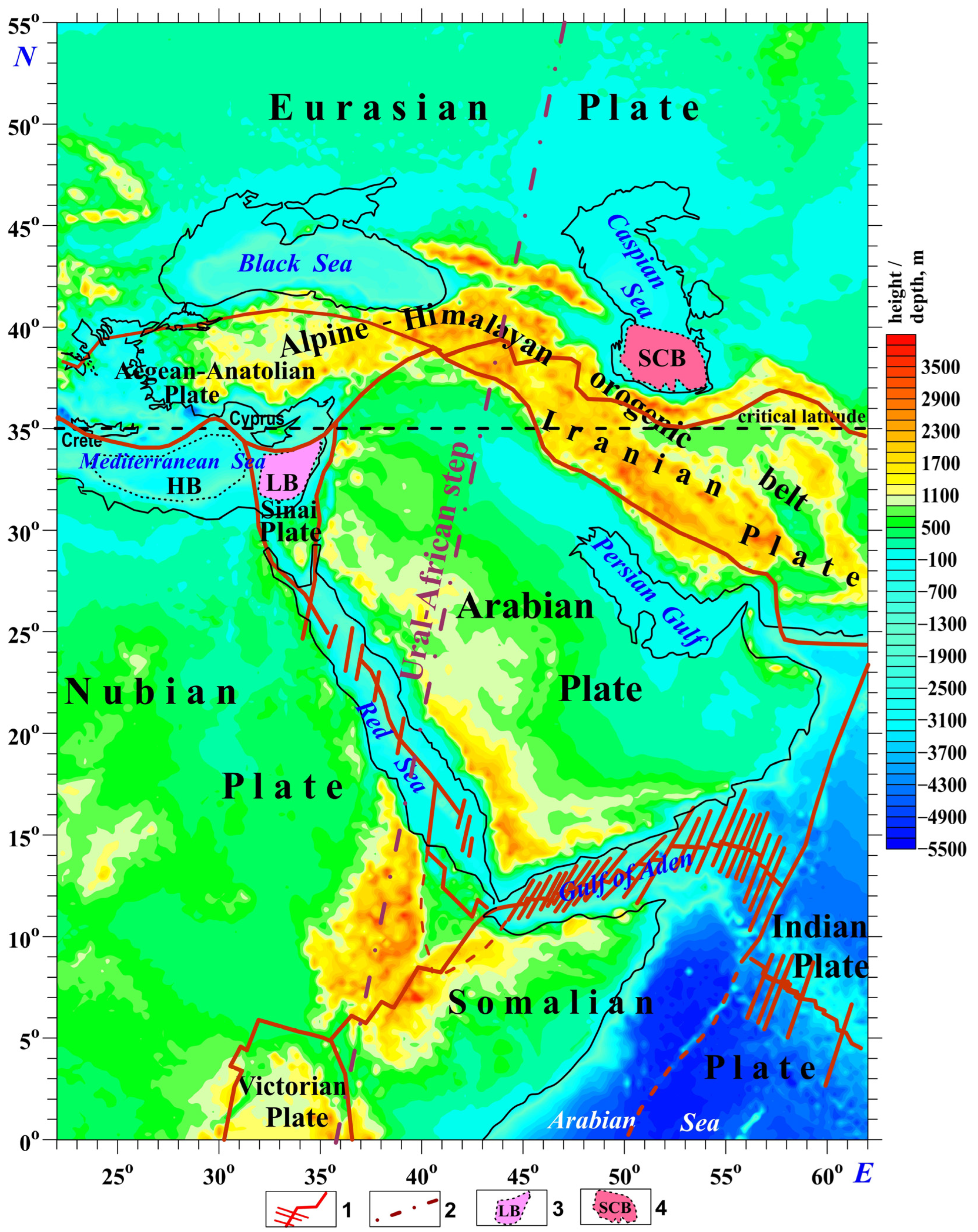
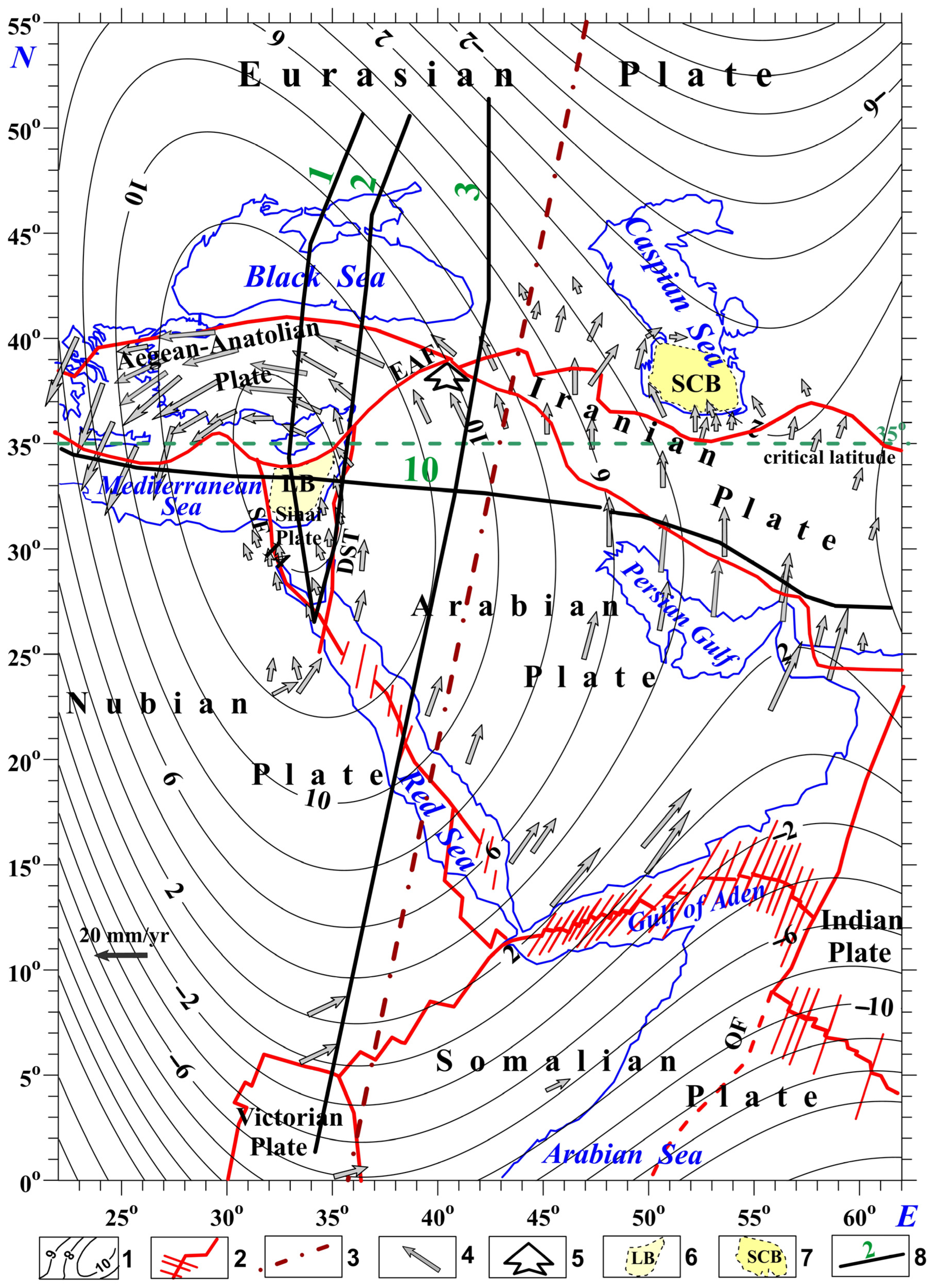
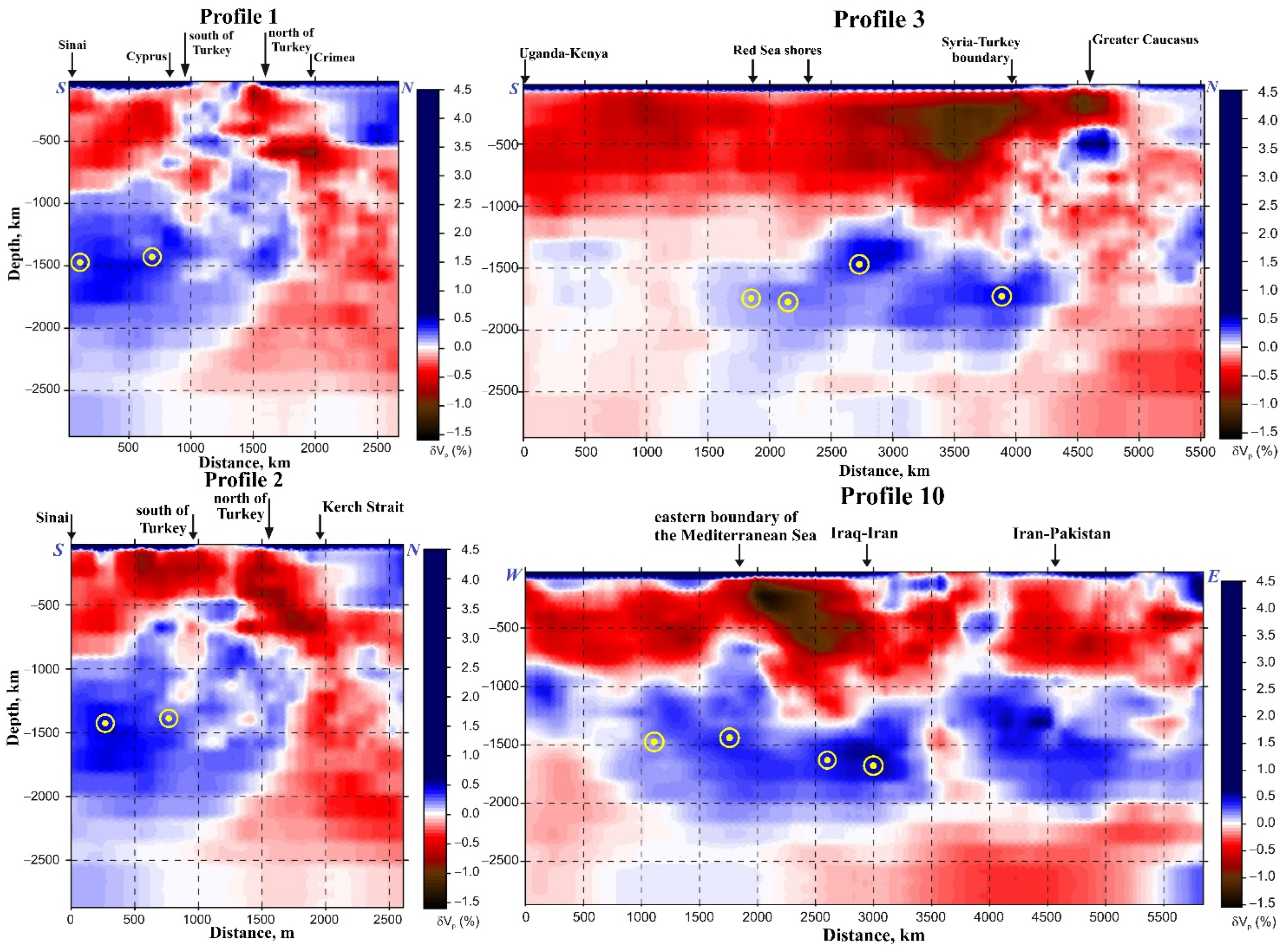
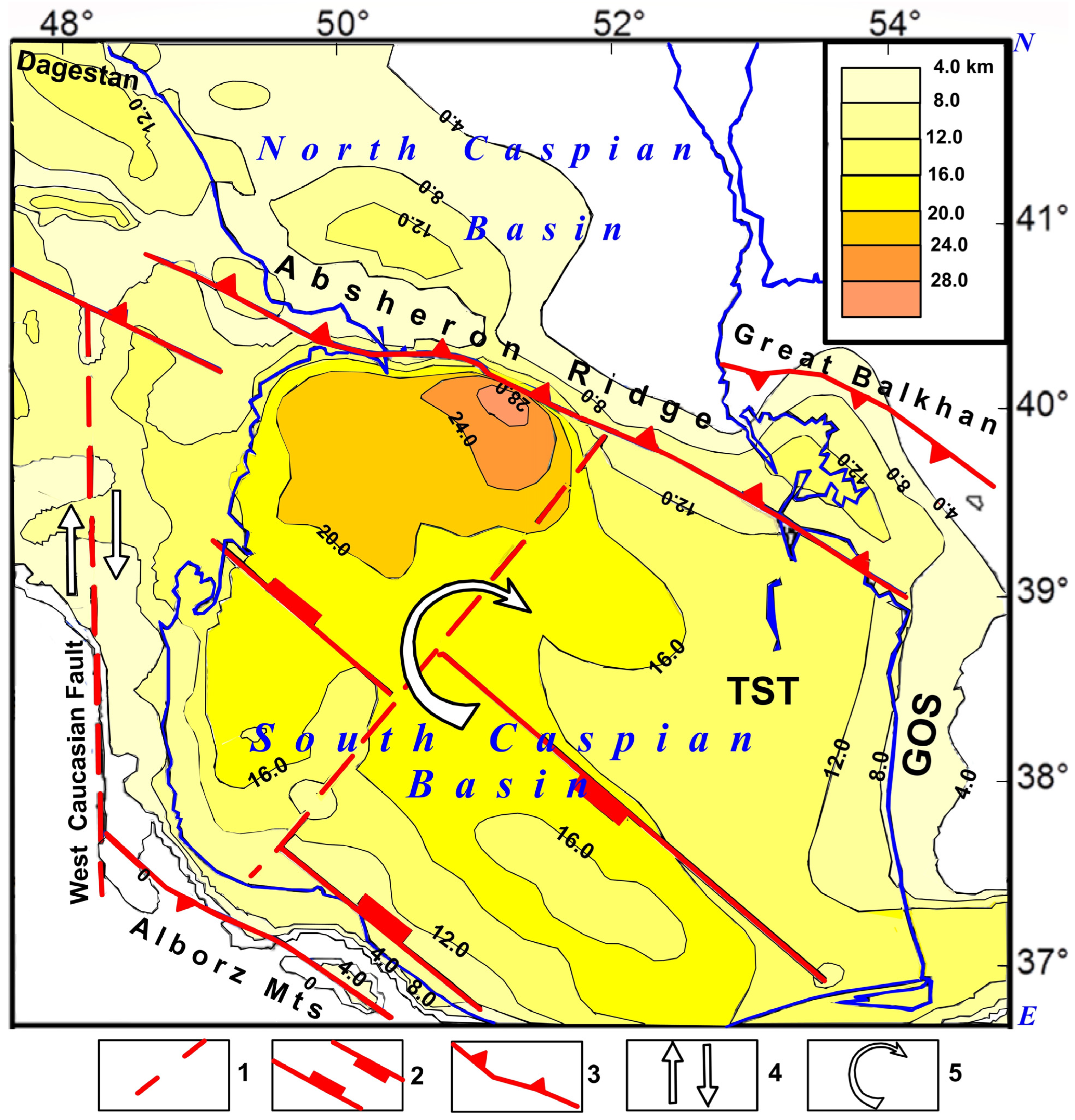
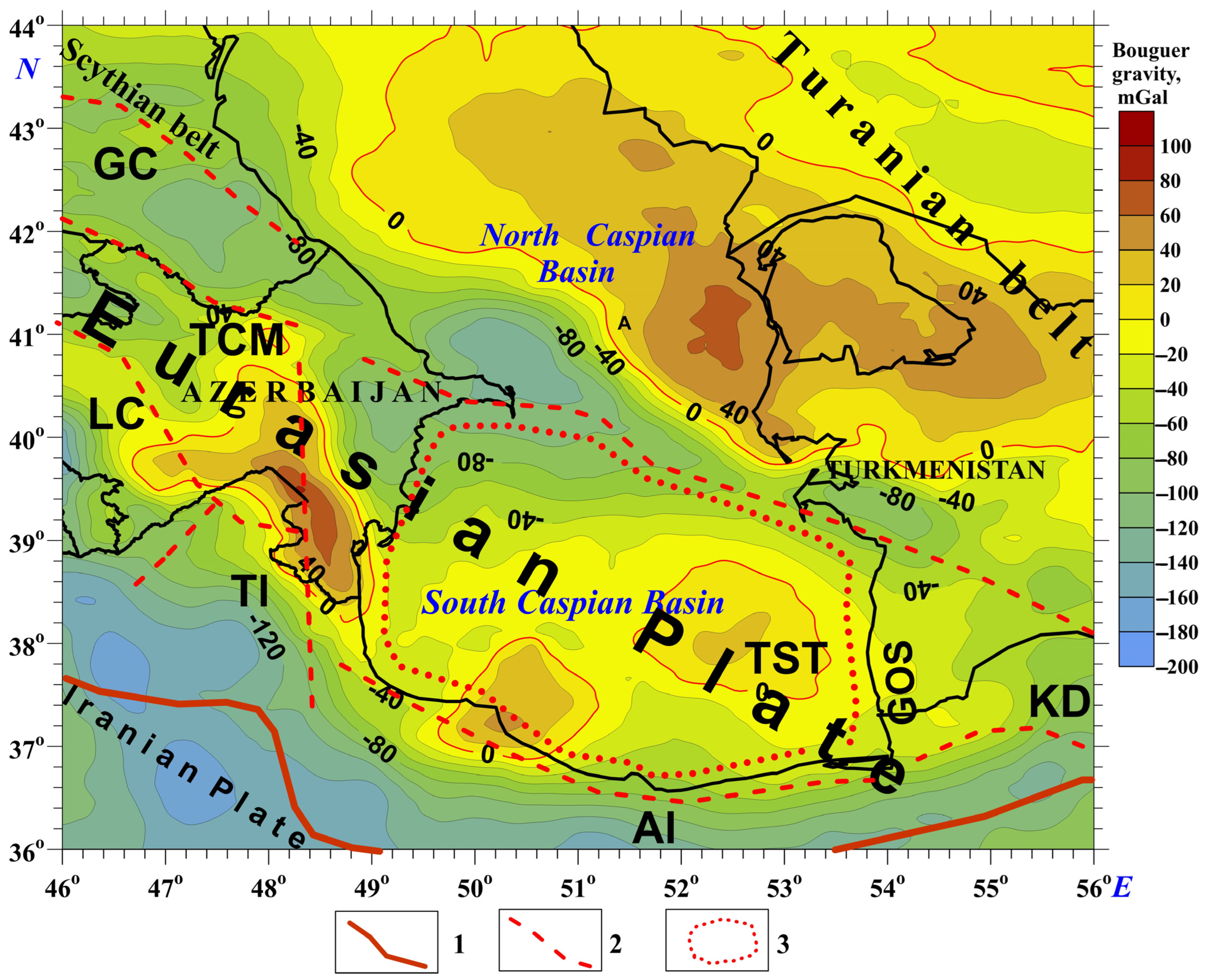
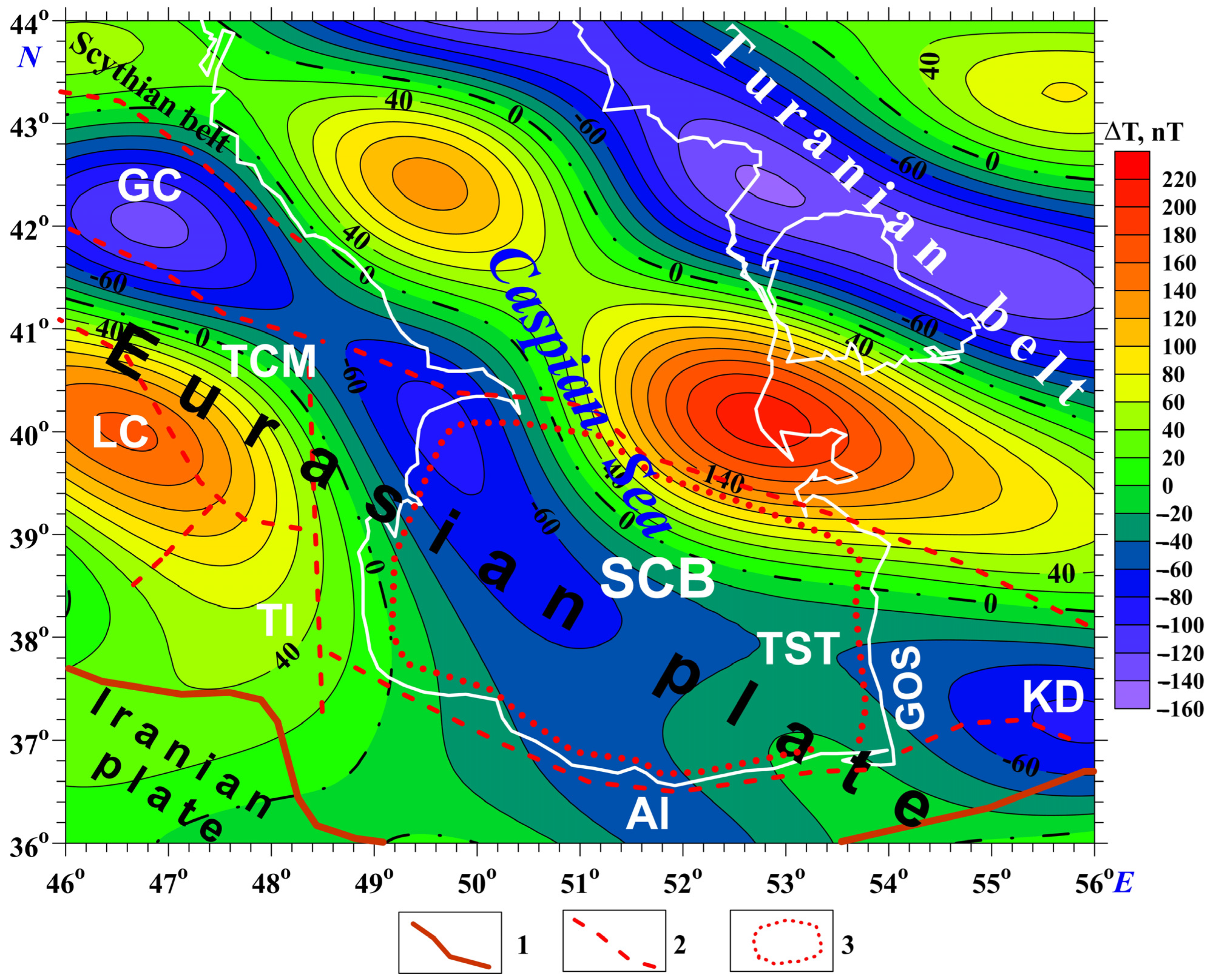

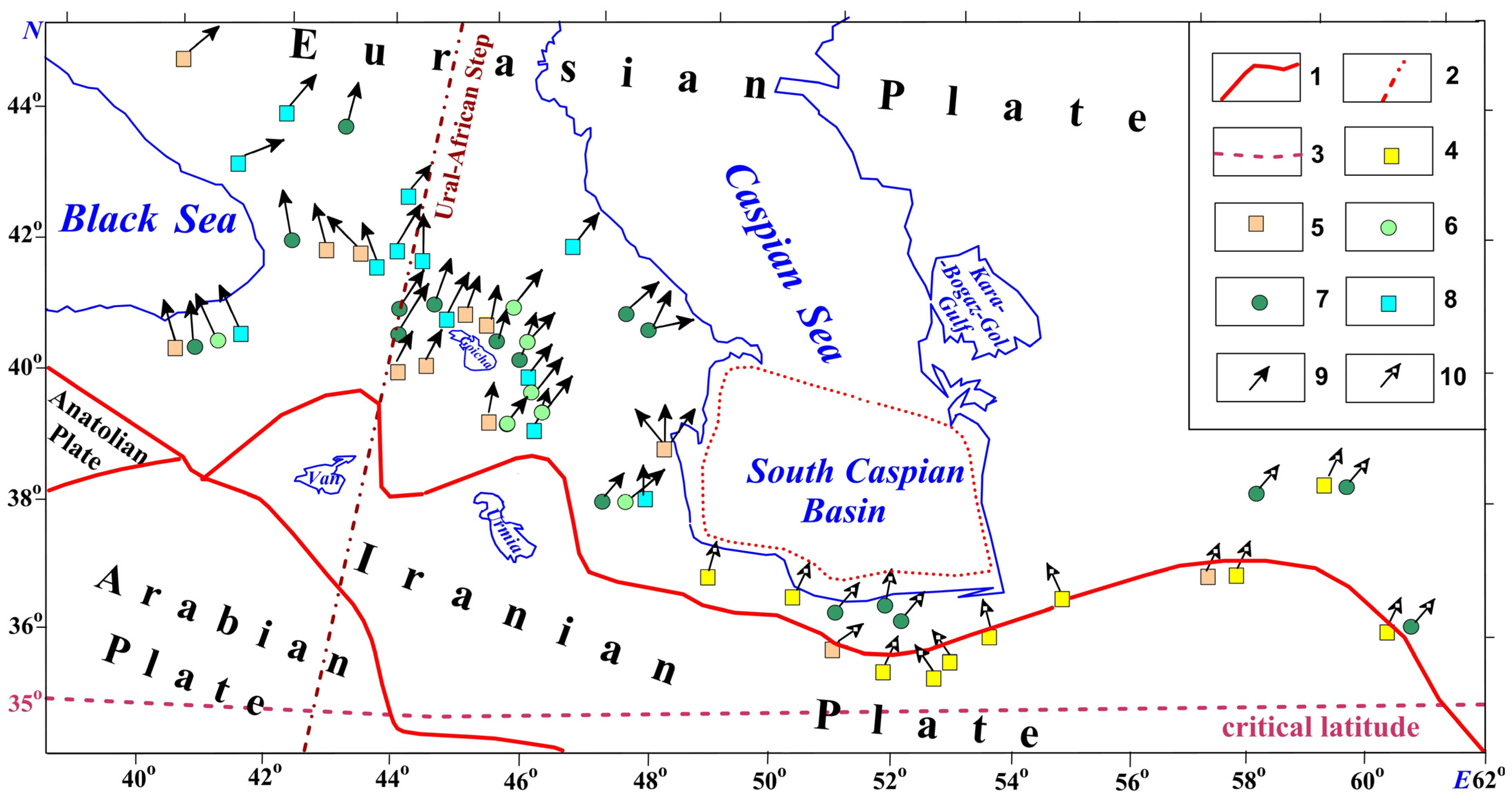
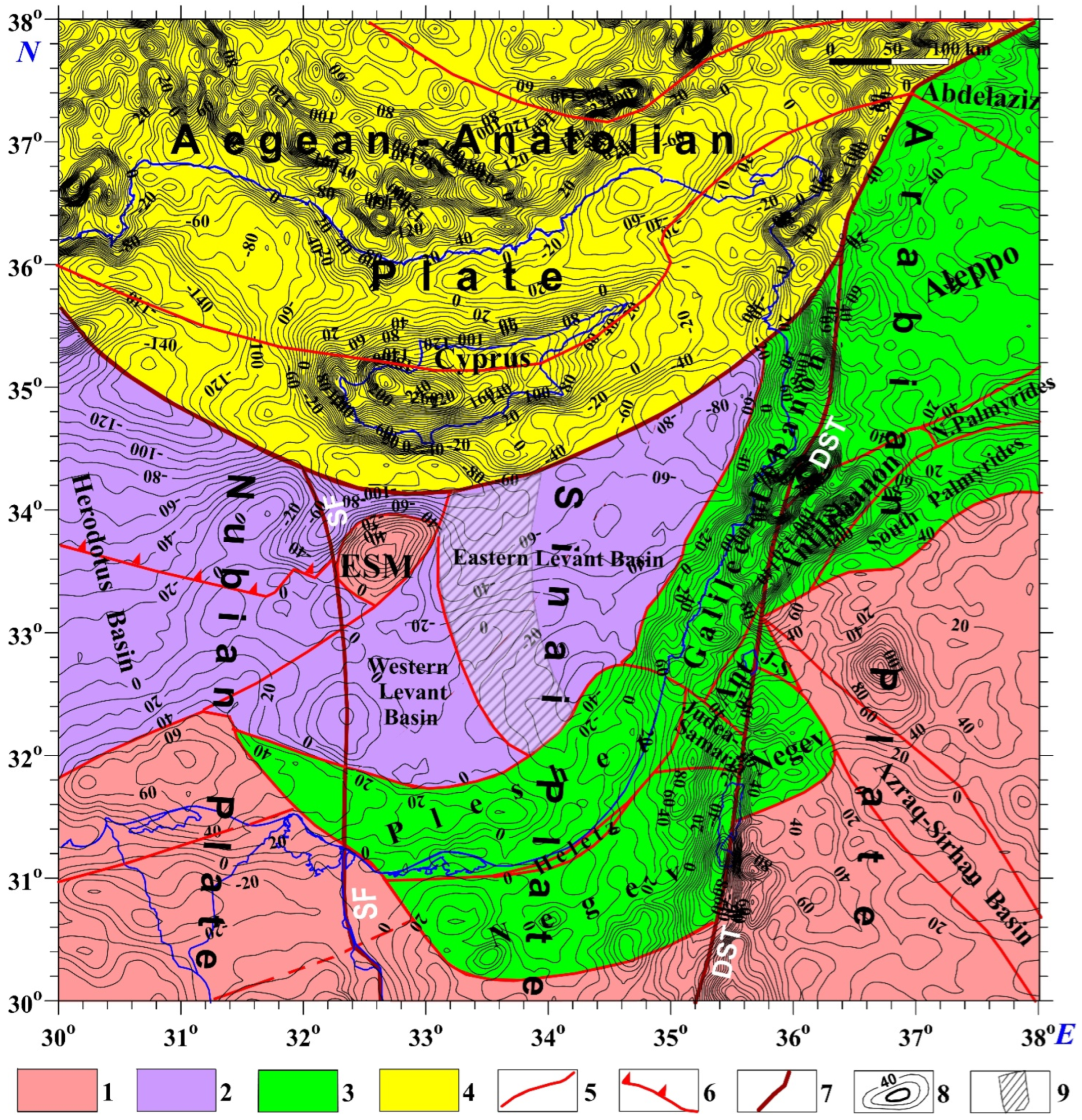
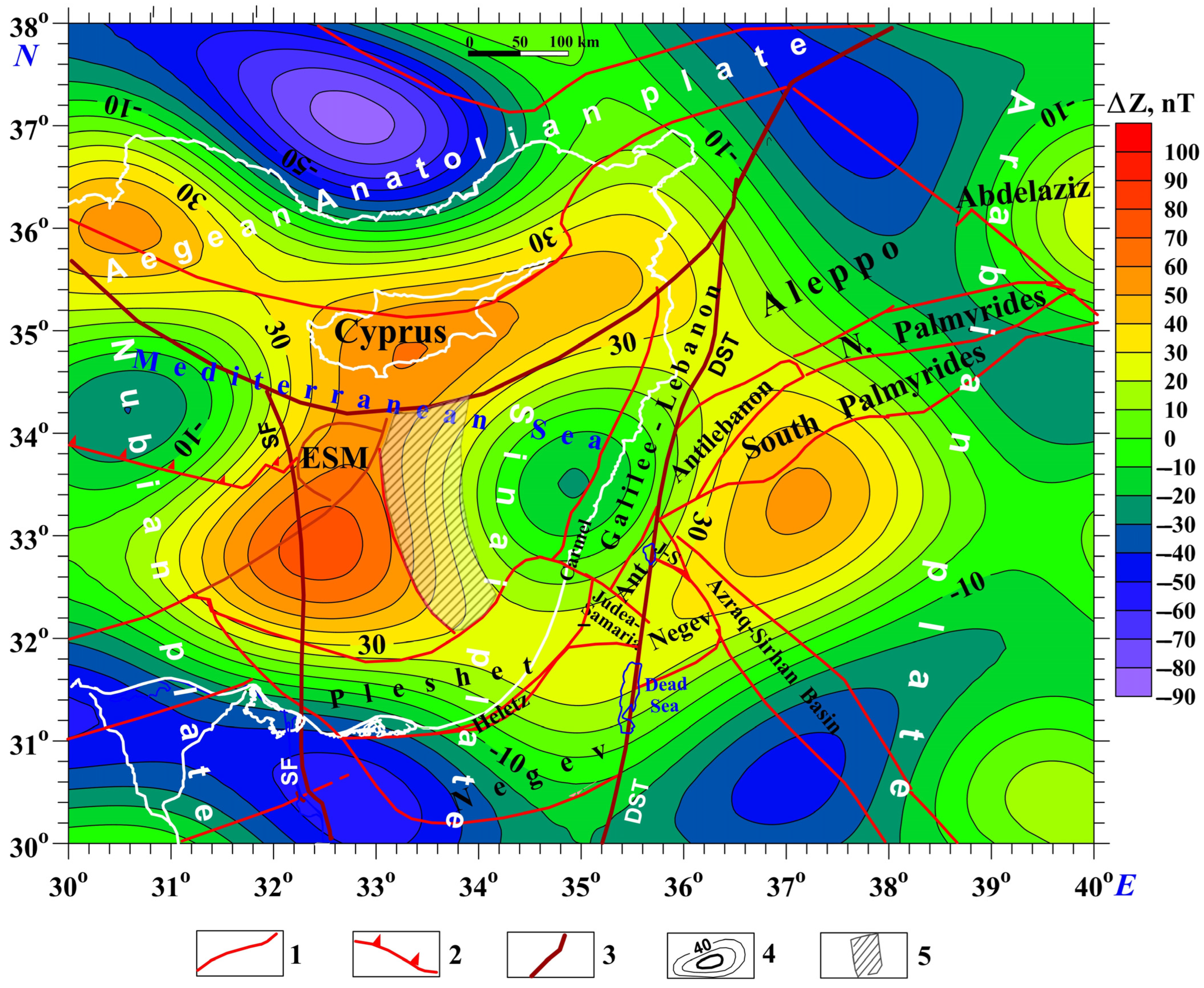
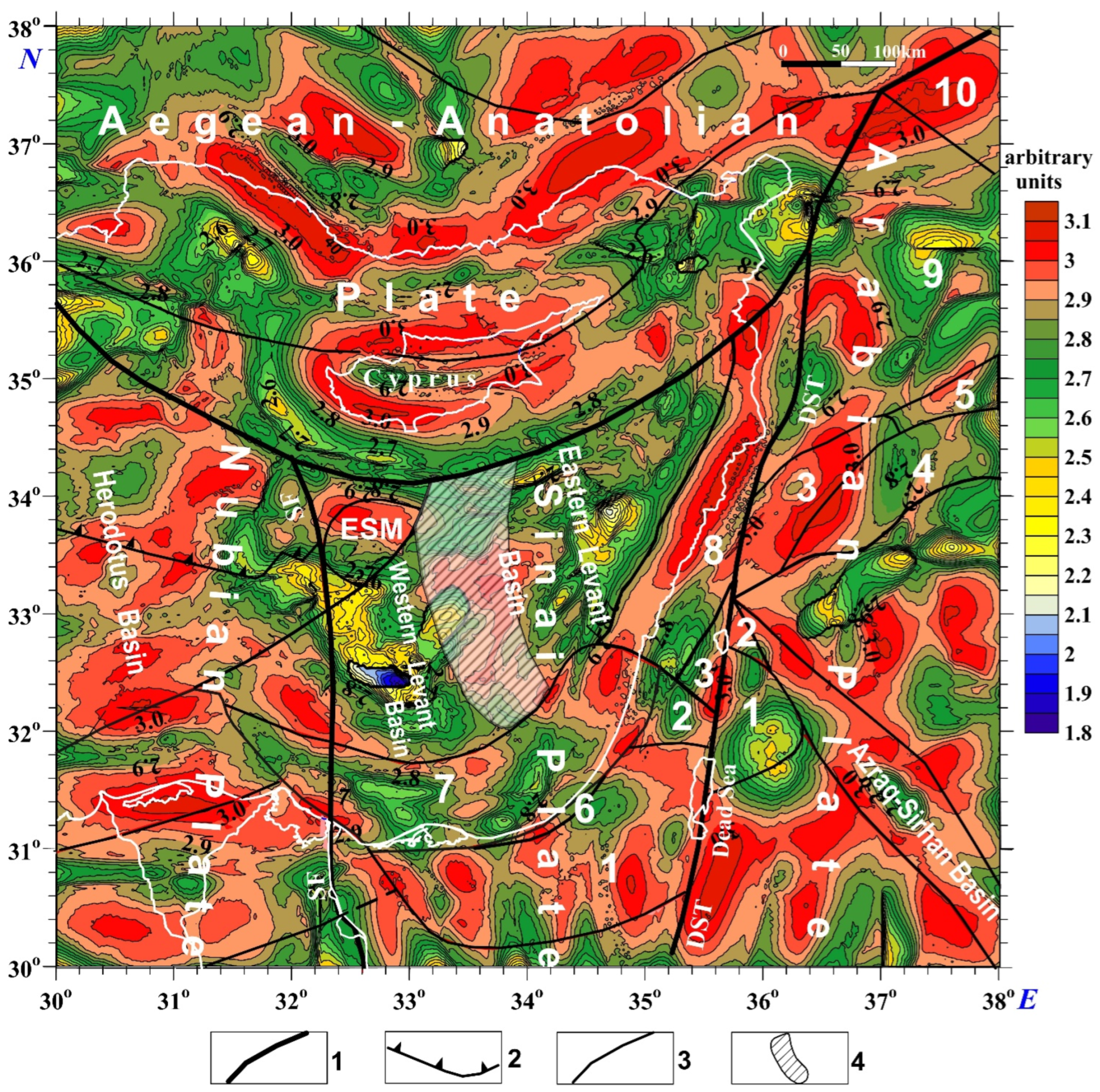
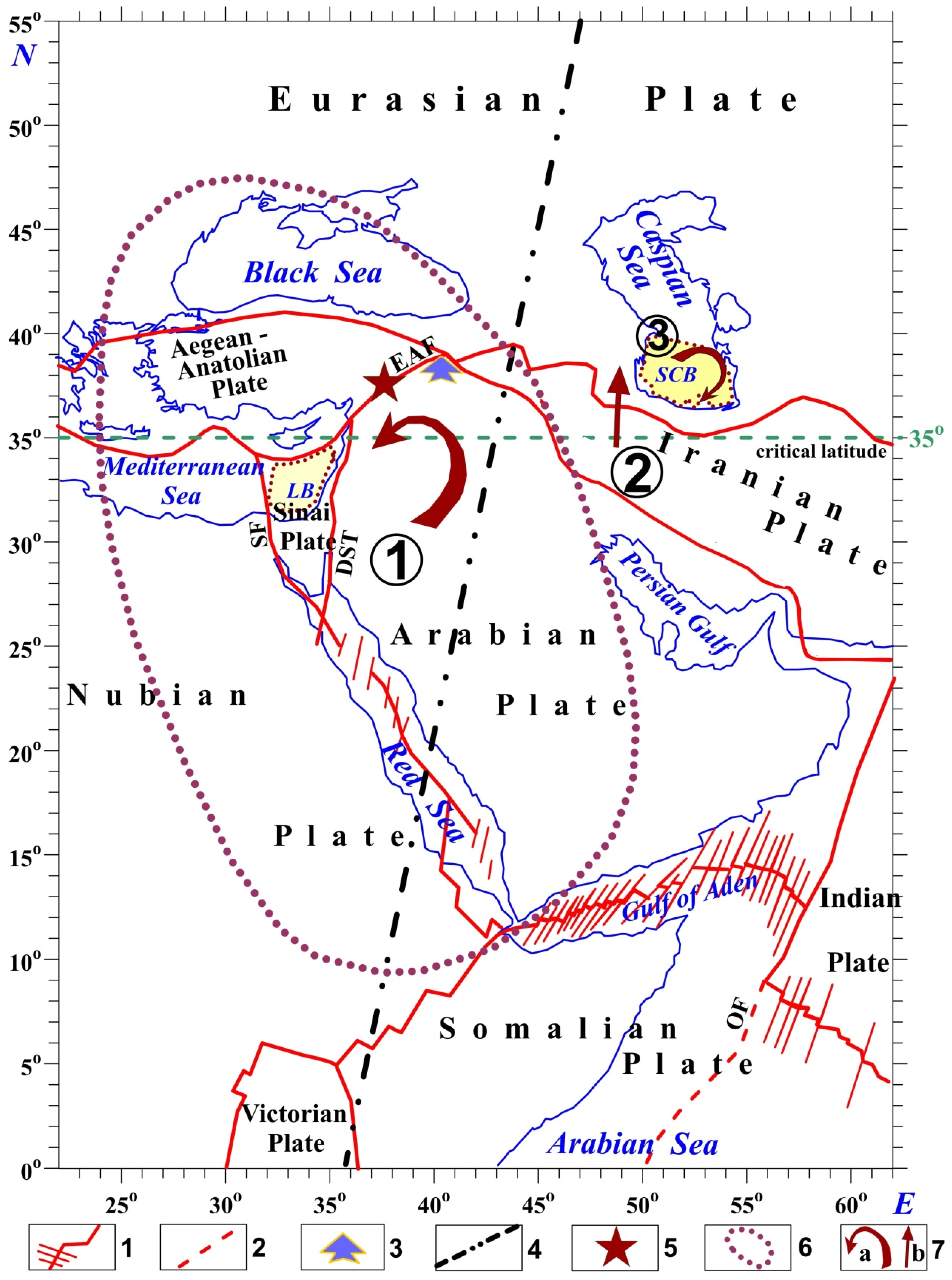
| N | Factor | South Caspian Basin (SCB) | Levant Basin (LB) |
|---|---|---|---|
| 1 | Area | ~200,000 km2 | ~150,000 km2 |
| 2 | Paleogeographic pattern | Relates to the eastern part of the remnant basin of the Paratethys [3,15,71] | Relates to the east boundary part of the remnant Neotethys–Mediterranean Ocean [2,3] |
| 3 | Plate tectonics position | Eastern Caucasian part of the Eurasian Plate [11,15,67] | The northern part of the Sinai Plate [11,15,77] |
| 4 | Main tectonic peculiarities | The SCB basin is separated from the surrounding tectonic uplifts of the Alpine belts by deep fault zones—Alburz, West Caucasian, and Apsheron [11,15,24,31,67,78,85]. In the eastern part, on the border with the Kopet-Dagh Alpines [73], the Gogran’dag-Okarem tectonic step is developed. The basin’s tectonic features include displaced blocks of oceanic and continental crust framed by a fault system | The LB is bounded from the south and east by the Mesozoic Terrane Belt [77] and from the north by an arcuate fault bordering a thick sequence of Cretaceous ophiolites and mantle diapirs of the Cyprus oceanic block system within the Anatolian Plate [1,15,81,89]. The LB is limited by submeridional deep faults on the west and east (influence of the giant rotating mantle structure) [9,10] |
| 5 | Characteristic tectonic–geodynamic features | The SCB tectonic basin is located above the zone of marginal periclinal subsidence of the quasi- ring mantle structure [9,25], where the dominant counterclockwise rotation mode is replaced by the opposite clockwise rotation [11,13,31] | The location of the LB above the apical zone of the mantle structure [25] explains the previously unclear phenomenon [9,10] of the counterclockwise rotation of the LB and its surrounding structures [25] |
| 6 | Type of Earth’s crust | Primarily oceanic, with separate continental crust blocks [23,24,38,56,64,65,68,70,72,79,85,90,116] | Oceanic, surrounded by continental terranes [2,77,88,117] |
| 7 | The origin of the Earth’s crust | Autochthonous [4,24,68,70,78] | Allochthonous (central-southern part of the LB) [3,77,115] |
| 8 | Oceanic crust age | ~170–230 Ma [39,56,69,118] | ≥225 Ma [7], Kiama block: ≥265 Ma [9,10,75] |
| 9 | Sedimentary thickness | Up to 28.5 km [16,24,34,54] | Up to 12–14 km [2,32,35,66] |
| 10 | Composition of sedimentary cover | Sedimentary deposits from the Jurassic to the Pleistocene [34,39,64] | Terrigenous–carbonate formations from the Upper Permian to the Late Cenozoic [1,32,35] |
| 11 | Salt series | None discovered [34] | A thick sequence of the Upper Miocene (Messinian) salt [74,84,93] |
| 12 | Gravity field behavior | Middle-gradient, with a strong negative anomaly offshore of Baku [20,22,23] | High-gradient with the closely disposed giant positive and negative anomalies (Cyprus–Dead Sea area) [2,21,77] |
| 13 | Magnetic field behavior | Low- and middle-gradient [26,27,119,120] | Middle- and high-gradient [2,17,28,121] |
| 14 | Thermal regime | Low: 45–50 mW/m2 [56,57,58,59,60] | Low: 30–35 mW/m2 [53,54,55] |
| 15 | Seismicity | Heightened [13,31,58,63,99,100,101] | Moderate–heightened [111,112,113,114] |
| 16 | Mud volcanism | Several hundred mud volcanoes [34,78,98,122,123] | A few units of mud volcanoes are slightly west of the LB and possibly within the LB [36,103,104] |
| 17 | Hydrocarbon potential | Very high: several hundred oil and gas deposits [34,39,58,79,90,124] | High: about twenty gas deposits [32,88,105,106,107,108] |
Disclaimer/Publisher’s Note: The statements, opinions and data contained in all publications are solely those of the individual author(s) and contributor(s) and not of MDPI and/or the editor(s). MDPI and/or the editor(s) disclaim responsibility for any injury to people or property resulting from any ideas, methods, instructions or products referred to in the content. |
© 2025 by the authors. Licensee MDPI, Basel, Switzerland. This article is an open access article distributed under the terms and conditions of the Creative Commons Attribution (CC BY) license (https://creativecommons.org/licenses/by/4.0/).
Share and Cite
Eppelbaum, L.; Katz, Y.; Kadirov, F.; Guliyev, I.; Ben-Avraham, Z. Geodynamic, Tectonophysical, and Structural Comparison of the South Caspian and Levant Basins: A Review. Geosciences 2025, 15, 281. https://doi.org/10.3390/geosciences15080281
Eppelbaum L, Katz Y, Kadirov F, Guliyev I, Ben-Avraham Z. Geodynamic, Tectonophysical, and Structural Comparison of the South Caspian and Levant Basins: A Review. Geosciences. 2025; 15(8):281. https://doi.org/10.3390/geosciences15080281
Chicago/Turabian StyleEppelbaum, Lev, Youri Katz, Fakhraddin Kadirov, Ibrahim Guliyev, and Zvi Ben-Avraham. 2025. "Geodynamic, Tectonophysical, and Structural Comparison of the South Caspian and Levant Basins: A Review" Geosciences 15, no. 8: 281. https://doi.org/10.3390/geosciences15080281
APA StyleEppelbaum, L., Katz, Y., Kadirov, F., Guliyev, I., & Ben-Avraham, Z. (2025). Geodynamic, Tectonophysical, and Structural Comparison of the South Caspian and Levant Basins: A Review. Geosciences, 15(8), 281. https://doi.org/10.3390/geosciences15080281









